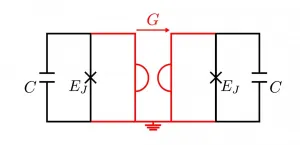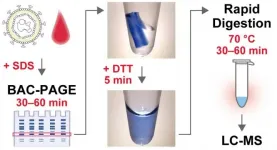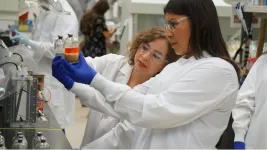Blueprint for fault-tolerant qubits
Scientists at Forschungszentrum Jülich and RWTH Aachen University have designed a circuit for quantum computers which is naturally protected against common errors
2021-02-18
(Press-News.org) Building a universal quantum computer is a challenging task because of the fragility of quantum bits, or qubits for short. To deal with this problem, various types of error correction have been developed. Conventional methods do this by active correction techniques. In contrast, researchers led by Prof. David DiVincenzo from Forschungszentrum Jülich and RWTH Aachen University, together with partners from the University of Basel and QuTech Delft, have now proposed a design for a circuit with passive error correction. Such a circuit would already be inherently fault protected and could significantly accelerate the construction of a quantum computer with a large number of qubits.
In order to encode quantum information in a reliable way, usually, several imperfect qubits are combined to form a so-called logical qubit. Quantum error correction codes, or QEC codes for short, thus make it possible to detect errors and subsequently correct them, so that the quantum information is preserved over a longer period of time.
In principle, the techniques work in a similar way to active noise cancellation in headphones: In a first step, any fault is detected. Then, a corrective operation is performed to remove the error and restore the information to its original pure form.
However, the application of such active error correction in a quantum computer is very complex and comes with an extensive use of hardware. Typically, complex error-correcting electronics are required for each qubit, making it difficult to build circuits with many qubits, as required to build a universal quantum computer.
The proposed design for a superconducting circuit, on the other hand, has a kind of built-in error correction. The circuit is designed in such a way that it is already inherently protected against environmental noise while still controllable. The concept thus bypasses the need for active stabilization in a highly hardware-efficient manner, and would therefore be a promising candidate for a future large-scale quantum processor that has a large number of qubits.
"By implementing a gyrator - a two port device that couples current on one port to voltage on the other - in between two superconducting devices (so called Josephson junctions), we could waive the demand of active error detection and stabilization: when cooled down, the qubit is inherently protected against common types of noise," said Martin Rymarz, a PhD student in the group of David DiVincenzo and first author of the paper, published in Physical Review X.
"I hope that our work will inspire efforts in the lab; I recognize that this, like many of our proposals, may be a bit ahead of its time", said David DiVincenzo, Founding Director of the JARA-Institute for Quantum Information at RWTH Aachen University and Director of the Institute of Theoretical Nanoelectronics (PGI-2) at Forschungszentrum Jülich. "Nevertheless, given the professional expertise available, we recognize the possibility to test our proposal in the lab in the foreseeable future".
David DiVincenzo is considered a pioneer in the development of quantum computers. Among other things, his name is associated with the criteria that a quantum computer must fulfil, the so-called "DiVincenzo criteria".
INFORMATION:
[Attachments] See images for this press release:

ELSE PRESS RELEASES FROM THIS DATE:
2021-02-18
Mass spectrometry (MS) is a powerful method for biomarker analysis because it enables highly sensitive and accurate measurement of target molecules in clinical samples. The application of MS to clinical diagnosis, such as neonatal metabolic screening, has been progressing with a focus on metabolite markers. MS measurement of proteins is currently mainly used for novel marker discovery studies, but there is a growing interest in its application in clinical marker diagnosis as an alternative to immunoassays.
MS-based quantification of protein biomarkers is mainly performed by a bottom-up approach using peptide fragments obtained by enzymatic ...
2021-02-18
A study of over 1,700 U.S. young people exposed to four major hurricanes found that just a few of them reported chronic stress, and the trajectories among most youth reflected recovery or low-decreasing post-traumatic stress (PTS) symptoms, according to research recently published in JAMA Network Open.
Titled "Trajectories of Post-traumatic Stress in Youths After Natural Disasters," the inquiry, conducted from August 2017 to August 2020, combined data from four studies of youths ages six to 16 who attended schools near the respective destructive paths of Hurricanes Andrew (1992), Charley (2004), Ike (2005) and Katrina (2008), from three to 26 months following the disasters. Fifty-four percent of ...
2021-02-18
Ancient alchemists dreamed of transforming base materials like lead into gold and other valuable commodities. While such efforts generally came to naught, researchers today are having some success in extracting a variety of useful products like aviation fuels, lubricants, solvents, food additives and plastics from organic waste.
The trick is accomplished with the aid of specialized bacteria, whose metabolic activities can convert simpler chemicals into useful products through a microbial growth process knows as chain elongation.
Anca Delgado, a researcher in the Biodesign Swette Center for Environmental Biotechnology at Arizona State University, has been exploring the phenomenon. In a new study, she describes ...
2021-02-18
EUGENE, Ore. -- Feb. 18, 2021 -- An abnormal suppression of the immune system linked to the onset of numerous diseases has been associated with poor functional regeneration of traumatic bone injuries.
Levels of immune cells and proteins circulating in the blood following traumatic injury combined with advanced data analytics could predict whether patients are likely to respond to treatment, said Robert Guldberg, executive director of the Phil and Penny Knight Campus for Accelerating Scientific Impact.
The project -- detailed in a paper published online ahead of print in the Proceedings of the National Academy of Sciences -- identified ...
2021-02-18
WASHINGTON--A potentially dangerous side effect of testosterone therapy for transgender men is an increase in red blood cells that can raise the risk of blood clots, heart attack or stroke, according to a new study published in the Endocrine Society's Journal of Clinical Endocrinology & Metabolism.
Gender diverse people make up an estimated 0.6% of the U.S. population and are defined as having gender identity that is not aligned with their sex recorded at birth. Transgender men often undergo testosterone therapy as part of their gender-affirming treatment. Erythrocytosis, a condition where your body makes too many red blood cells, is a common side effect of testosterone therapy that can increase the risk of blood clots, heart attack or stroke.
"Erythrocytosis is common ...
2021-02-18
Despite being one of the world's most charismatic species, tigers face uncertain futures primarily due to habitat fragmentation, human-wildlife conflict and poaching. As global tiger populations decline, so does their genetic diversity. But until now it's been unclear how the animals' dwindling numbers are affecting them at the genetic level.
To find out, researchers at Stanford University, the National Centre for Biological Sciences, India, and various zoological parks and NGOs sequenced 65 genomes from four of the surviving tiger subspecies. Their findings confirmed that strong genetic differences exist between different tiger subspecies but showed, surprisingly, that these differences emerged relatively recently, ...
2021-02-18
Transit-oriented development--which concentrates high-density housing, commercial activities and public spaces around a rapid transit station--can both be a boon and a bane for communities, suggests a new UBC study.
"Transit-oriented development (TOD) can reduce traffic congestion and air pollution, encourage active mobility, and revitalize a neighbourhood," explains study author Craig E. Jones, a PhD candidate in geography and the research coordinator for the Housing Research Collaborative at UBC's faculty of applied science.
"However, it can also cause gentrification through the demolition of affordable rental housing. It can tailor the area towards condo ...
2021-02-18
PHOENIX, Ariz. and DUARTE, Calif. -- Feb. 17, 2021 -- Urinalysis has long been a staple of physical exams to detect and manage a number of diseases and disorders, but not cancer. What if it were that easy, though, and cancer was detected in its very earliest stages when the disease responds more favorably to treatment and improved outcomes are more likely?
That was the question posed by scientists at the Translational Genomics Research Institute (TGen), an affiliate of City of Hope, who have found a way of zeroing in on early-stage cancer by analyzing short strands of cell-free DNA in urine. Their study's findings were published today in the scientific journal Science ...
2021-02-18
Severe forms of malaria such as Plasmodium falciparum may be deadly even after treatment with current parasite-killing drugs. This is due to persistent cyto-adhesion of infected erythrocytes even though existing parasites within the red blood cells are dead. As vaccines for malaria have proved less than moderately effective, and to treat these severe cases of P. falciparum malaria, new avenues are urgently needed. Latest estimates indicate that more than 500 million cases of malaria and more than 400,000 deaths are reported worldwide each year. Anti-adhesion drugs may hold the key to significantly improving survival rates.
Using venom from the Conus nux, a species of sea snail, a first-of-its-kind study ...
2021-02-18
Extending the symptoms that trigger a PCR test for COVID-19 could help detect around a third more cases of the disease.
New research led by researchers at King's College London and published in the Journal of Infection suggests that restricting testing to the 'classic triad' of cough, fever and loss of smell which is required for eligibility for a PCR test through the NHS may have missed cases. Extending the list to include fatigue, sore throat, headache and diarrhoea would have detected 96% of symptomatic cases.
A team of researchers at King's College London and the Coalition for Epidemic Preparedness Innovations (CEPI) analysed data from more than 122,000 UK adult users of the ZOE COVID Symptom Study app. These users reported experiencing ...
LAST 30 PRESS RELEASES:
[Press-News.org] Blueprint for fault-tolerant qubits
Scientists at Forschungszentrum Jülich and RWTH Aachen University have designed a circuit for quantum computers which is naturally protected against common errors




